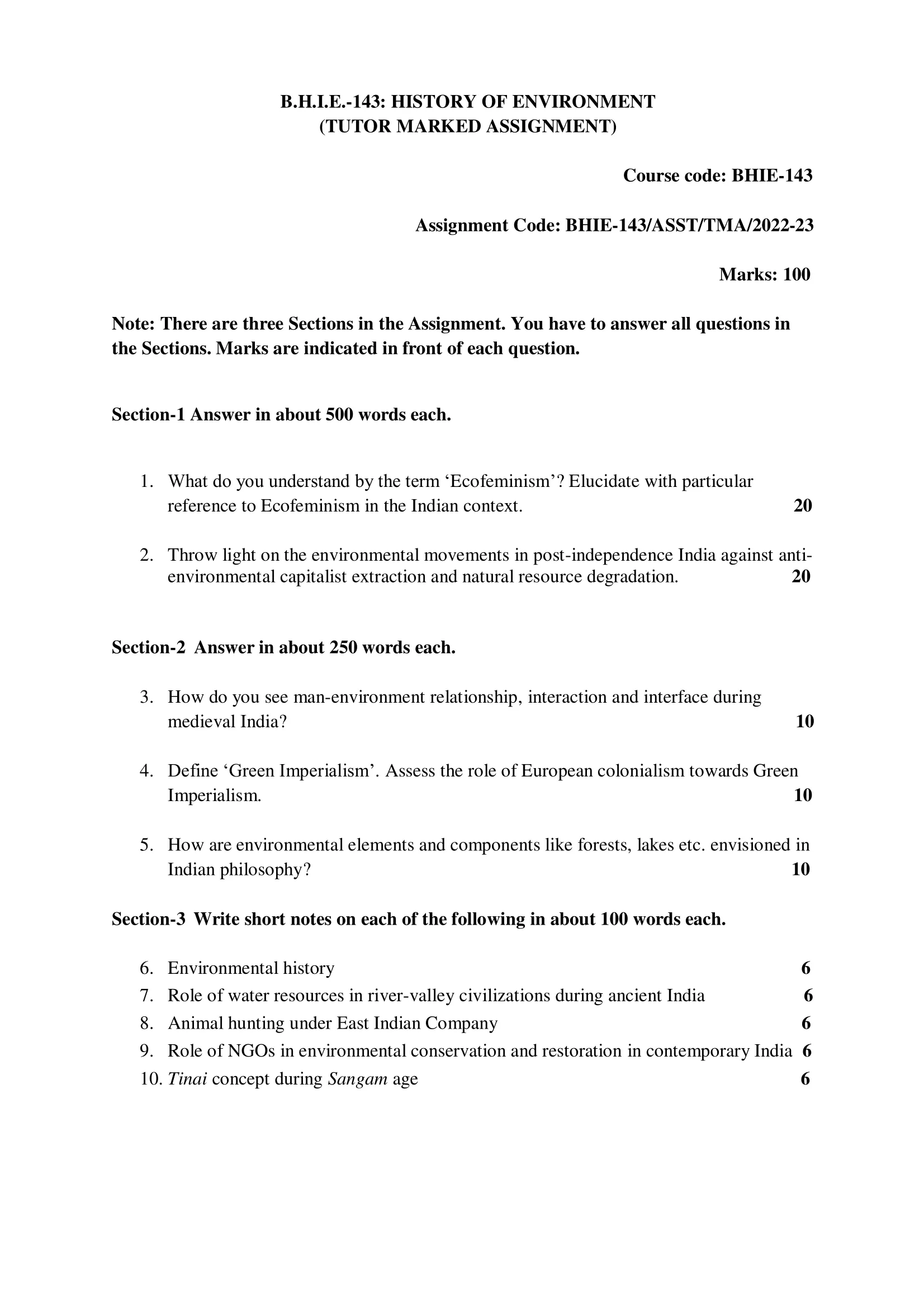Contents
- 1 Section-1 Answer in about 500 words each.
- 2 1. What do you understand by the term ‘Ecofeminism’? Elucidate with particular reference to Ecofeminism in the Indian context.
- 3 2. Throw light on the environmental movements in post-independence India against antienvironmental capitalist extraction and natural resource degradation.
- 4 Section-2 Answer in about 250 words each.
- 5 3. How do you see man-environment relationship, interaction and interface during medieval India?
- 6 4. Define ‘Green Imperialism’. Assess the role of European colonialism towards Green Imperialism.
- 7 5. How are environmental elements and components like forests, lakes etc. envisioned in Indian philosophy?
- 8 Section-3 Write short notes on each of the following in about 100 words each.
- 9 6. Environmental history.
- 10 7. Role of water resources in river-valley civilizations during ancient India.
- 11 8. Animal hunting under East Indian Company.
- 12 9. Role of NGOs in environmental conservation and restoration in contemporary India.
- 13 10. Tinai concept during Sangam age.

| Title | BHIE-143: IGNOU BAG Solved Assignment 2022-2023 (HISTORY OF ENVIRONMENT) |
| University | IGNOU |
| Degree | Bachelor Degree Programme |
| Course Code | BHIE-143 |
| Course Name | HISTORY OF ENVIRONMENT |
| Programme Name | Bachelor of Arts (General) |
| Programme Code | BAG |
| Total Marks | 100 |
| Year | 2022-2023 |
| Language | English |
| Assignment Code | BHIE-143/ASST/TMA/2022-23 |
| Last Date for Submission of Assignment: | For June Examination: 31st April For December Examination: 30th September |

Section-1 Answer in about 500 words each.
1. What do you understand by the term ‘Ecofeminism’? Elucidate with particular reference to Ecofeminism in the Indian context.
Ans: Ecofeminism refers to a social movement and academic discipline that recognizes the interconnectedness of environmental degradation and the oppression of women. It asserts that the exploitation of nature and the oppression of women are interconnected and rooted in patriarchal attitudes and practices.
In the Indian context, ecofeminism has gained traction in recent years as a response to the numerous environmental and social justice issues faced by Indian women. For example, Indian women who live in rural areas are often the primary caretakers of natural resources and are directly impacted by environmental degradation. The contamination of water sources and the loss of fertile land has a disproportionate impact on women and their ability to provide for their families.
Furthermore, Indian women also face multiple forms of gender-based violence, including dowry-related violence, domestic violence, and sexual assault, which are perpetuated by the same patriarchal structures that drive environmental degradation. As such, ecofeminism in India seeks to address both environmental and gender-based issues by advocating for the rights of women and the protection of the environment.
Ecofeminism in India also highlights the need for a more holistic approach to development, one that prioritizes environmental sustainability and the empowerment of women. For example, ecofeminism supports initiatives that promote alternative forms of agriculture, such as organic farming, which are less harmful to the environment and can provide women with a source of livelihood. It also promotes renewable energy sources and the use of traditional knowledge and practices to conserve natural resources.
2. Throw light on the environmental movements in post-independence India against antienvironmental capitalist extraction and natural resource degradation.
Ans: Environmental movements in post-independence India have been driven by concerns over anti-environmental capitalist extraction and degradation of natural resources. Since the early 1960s, India has experienced rapid industrialization and economic growth, which has resulted in the degradation of natural resources and the environment. This has led to widespread opposition from civil society and the growth of environmental movements.
One of the most prominent environmental movements in India was the Chipko Movement, which was started in the 1970s to protect forests from deforestation and commercial exploitation. The movement gained national and international attention and inspired similar movements across the world. The Chipko Movement was largely led by women, who hugged trees to prevent loggers from cutting them down. The movement led to the creation of forest conservation laws and policies, which protected forests and their ecological services.
Another important environmental movement in India is the Narmada Bachao Andolan (Save the Narmada Movement), which was started in the 1980s to protest the construction of large dams on the Narmada River. The movement was led by local communities and environmental activists, who argued that the dams would displace millions of people and destroy the environment. The movement led to the creation of policies that regulated the construction of dams and ensured that the rights of local communities were protected.
In recent years, India has also seen the growth of environmental movements against mining, which is a major source of environmental degradation in the country. The mining industry in India has been criticized for its environmental impact, including deforestation, soil erosion, water pollution, and the destruction of wildlife habitats. Environmental movements against mining have been led by local communities and environmental activists, who have organized protests and demonstrations to demand the cessation of mining activities in ecologically sensitive areas.
Section-2 Answer in about 250 words each.
3. How do you see man-environment relationship, interaction and interface during medieval India?
Ans: Medieval India saw a complex relationship between man and the environment, characterized by a delicate balance between the use of natural resources and conservation efforts. The interactions and interfaces between human populations and the environment during this time period were shaped by a variety of factors, including religious beliefs, social and economic systems, and technological advancements.
Religion played a significant role in shaping medieval India’s relationship with the environment. Hinduism and Buddhism, the two dominant religions at the time, placed great value on the protection of nature and the conservation of natural resources. Both religions emphasized the importance of preserving the balance between human activity and the environment, and many religious texts contained teachings and guidelines for sustainable resource use.
Medieval India’s social and economic systems also influenced the man-environment relationship. The feudal system and the caste system restricted access to resources and land, and created unequal distribution of wealth and power, leading to the degradation of the environment in some regions. Agricultural practices, such as irrigation systems and terracing, were developed and improved upon, leading to increased food production and economic growth.
Technology also played a role in shaping the man-environment relationship in medieval India. The development of new tools and techniques for resource extraction and processing, as well as advances in transportation and communication, facilitated the exploitation of natural resources and the expansion of human populations. This increase in human activity also led to the degradation of the environment in some regions.
4. Define ‘Green Imperialism’. Assess the role of European colonialism towards Green Imperialism.
Ans: Green imperialism refers to the control and exploitation of natural resources, land, and biodiversity by developed countries in the name of environmental protection and conservation. It is often carried out under the guise of sustainable development or through international environmental agreements, but in reality, it serves the interests of the developed world at the expense of the developing world.
European colonialism played a significant role in the development of green imperialism. During the colonial era, European powers such as Britain, France, and Spain, colonized and exploited the resources of the developing world, often with devastating environmental consequences. They imposed their own economic, political, and environmental systems, which often failed to respect the rights and livelihoods of local communities.
In the post-colonial era, green imperialism has continued to play out in various forms. Developed countries, such as those in Europe, have used international environmental agreements and initiatives to assert their control over developing countries’ resources and biodiversity, often under the guise of environmental protection and conservation. They use their economic and political power to dictate the environmental policies and regulations of developing countries, and to gain access to their resources and markets.
5. How are environmental elements and components like forests, lakes etc. envisioned in Indian philosophy?
Ans: Indian philosophy has long recognized the intrinsic value of environmental elements and components such as forests, lakes, and other natural resources. From the ancient scriptures of Hinduism and Buddhism to the later development of Jainism and Sikhism, the Indian philosophical tradition has placed great importance on the protection and conservation of the natural world.
In Hinduism, for example, the concept of “pancha mahabhuta” or five elements (earth, water, fire, air, and ether) is central to the understanding of the universe and the interconnectedness of all living things. The natural world, including forests and lakes, is seen as a manifestation of these elements and therefore deserving of respect and protection. Hindu scriptures also emphasize the importance of maintaining a balance between human activity and the environment, and many Hindu festivals and rituals are centered around the worship of nature.
In Buddhism, the concept of “dependent origination” holds that all things arise in dependence on other things and therefore are interdependent and interconnected. This includes the relationship between humans and the environment. Buddhist teachings emphasize the importance of living in harmony with nature and avoiding actions that cause harm to the environment.
Jainism, with its principle of non-violence (ahimsa), places a strong emphasis on environmental protection and conservation. Jain scriptures encourage the protection of all forms of life, including plants and animals, and the avoidance of actions that cause harm to the environment.
Sikhism, with its focus on the interconnectedness of all things and the importance of living in harmony with nature, also stresses the importance of environmental protection. The Sikh scripture, the Guru Granth Sahib, contains numerous references to the beauty and value of the natural world and encourages responsible resource use.
Section-3 Write short notes on each of the following in about 100 words each.
6. Environmental history.
Ans: Environmental history is the study of the relationship between humans and the natural world, focusing on the interactions and impacts that humans have had on the environment over time. It encompasses the study of climate change, habitat loss, pollution, and species extinction, as well as the development of conservation movements and environmental policies. Environmental history is important because it provides a deeper understanding of the complex and interconnected systems that make up our planet and how our actions have both positive and negative effects on the environment. By understanding our past, we can better plan for a sustainable future and ensure that future generations can thrive in a healthy and protected environment.
7. Role of water resources in river-valley civilizations during ancient India.
Ans: Water resources played a crucial role in the development and sustainability of river-valley civilizations in ancient India. The Indus and Ganges river systems provided water for agriculture, commerce, and transportation, enabling the growth of cities and civilizations such as the Indus Valley Civilization and the Mauryan Empire. The construction of dams, canals, and water storage systems allowed for efficient irrigation and flood control, boosting agricultural productivity and food security. Religion also played a role, with rivers and water sources revered as sacred and central to spiritual practices. Despite challenges posed by monsoons and floods, water management was critical to the prosperity of ancient Indian civilizations and remains so today.
8. Animal hunting under East Indian Company.
Ans: Under the East India Company, animal hunting became a widespread and lucrative activity in India. The company’s administrators and military personnel were among the prominent hunters, pursuing big-game animals such as tigers, lions, and elephants for sport and personal trophies. The East India Company also facilitated the trade of animal skins and body parts, which were in high demand in Europe and other parts of the world. This rampant hunting led to the decline of many animal species and the destruction of their habitats. The British colonial government later introduced hunting laws and regulations, but these were often disregarded or poorly enforced. Hunting continued to have a significant impact on India’s wildlife until the country’s independence and the implementation of stricter conservation measures.
9. Role of NGOs in environmental conservation and restoration in contemporary India.
Ans: Non-Governmental Organizations (NGOs) play a crucial role in environmental conservation and restoration efforts in contemporary India. These organizations work to raise awareness about environmental issues, mobilize public support, and advocate for government policies that promote conservation and restoration. NGOs also engage in direct conservation and restoration activities, such as planting trees, restoring wetlands, and conserving endangered species.
NGOs work closely with communities and local organizations to promote sustainable resource use and empower local populations to become stewards of their environment. They also collaborate with government agencies and other stakeholders to implement large-scale conservation and restoration initiatives.
In recent years, the role of NGOs in environmental conservation and restoration has become increasingly important in India, as the country faces growing environmental challenges such as deforestation, wildlife poaching, and pollution. The contributions of NGOs have helped to mitigate these challenges and promote a more sustainable future for India and its people.
10. Tinai concept during Sangam age.
Ans: The concept of “Tinai” was central to the literary and cultural traditions of the Sangam age in ancient South India. The Tinai concept refers to the classification of land into different ecological regions, each with its unique flora, fauna, and cultural practices. There were five Tinais in the Sangam literature: Kurinji (mountainous), Mullai (pastoral), Marudham (agricultural), Neidhal (coastal), and Palai (arid). Each Tinai was associated with specific seasons, emotions, and social norms, and was considered to have a unique character and flavor. The Tinai concept reflected the close connection between the environment and the cultural practices of the people, and the importance of maintaining a balance between human activity and the natural world. The Tinai concept continues to influence the cultural traditions of South India to this day.
How to Download BHIE-143 Solved Assignment?
You can download it from the www.edukar.in, they have a big database for all the IGNOU solved assignments.
Is the BHIE-143 Solved Assignment Free?
Yes this is absolutely free to download the solved assignment from www.edukar.in
What is the last submission date for BHIE-143 Assignment?
For June Examination: 31st April, For December Examination: 30th October








![[Solved Assignment] BPCS 188-APPLICATIONS OF SOCIAL PSYCHOLOGY (IGNOU-BAG) 2022-2023 BPCS 188-APPLICATIONS OF SOCIAL PSYCHOLOGY IGNOU BAG Solved Assignment 2022-2023](https://edukar.in/wp-content/uploads/2023/01/BPCS-188-APPLICATIONS-OF-SOCIAL-PSYCHOLOGY-IGNOU-BAG-Solved-Assignment-2022-2023-1024x640.webp)







